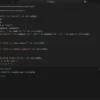Python is one of the most popular and versatile programming languages in the world. It is widely used for web development, data analysis, machine learning, artificial intelligence, and more. But is it a good idea to learn python programming at primary school level?
In this blog post, I will explore some of the benefits and challenges of teaching python to young children. I will also share some tips and resources for parents and teachers who want to introduce python to their kids.
Benefits of learning python at primary school level
Python has many advantages as a first programming language for children. Some of them are:
– Python is easy to read and write. It has a simple and consistent syntax that avoids unnecessary symbols and keywords. It also uses indentation to structure the code, which makes it more readable and organized.
– Python is expressive and powerful. It allows children to create complex programs with fewer lines of code than other languages. It also has many built-in features and libraries that make it easy to perform various tasks, such as working with text, images, sounds, games, etc.
– Python is fun and creative. It encourages children to experiment and explore different possibilities with their code. It also supports multiple paradigms, such as procedural, object-oriented, and functional programming, which allow children to express their ideas in different ways.
– Python is relevant and useful. It exposes children to real-world applications and problems that can be solved with programming. It also prepares them for future learning and careers in STEM fields, as python is widely used in many domains and industries.
Challenges of learning python at primary school level
Despite its benefits, python also has some drawbacks and difficulties as a first programming language for children. Some of them are:
– Python is abstract and conceptual. It requires children to understand some basic concepts of programming, such as variables, data types, functions, loops, conditions, etc. These concepts can be challenging for young children who are still developing their logical and mathematical thinking skills.
– Python is dynamic and flexible. It does not enforce strict rules or types on the code, which can lead to errors and bugs that are hard to detect and fix. It also allows children to write code in different ways, which can cause confusion and inconsistency.
– Python is diverse and evolving. It has many versions, dialects, frameworks, and libraries that can vary in syntax, functionality, and compatibility. It also changes frequently with new updates and features that can make the code obsolete or incompatible.
– Python is dependent and limited. It relies on external tools and environments to run the code, such as editors, interpreters, compilers, etc. These tools can be complex to install and use for beginners. It also has some limitations in performance, speed, memory usage, etc., that can affect the quality and efficiency of the code.
Tips and resources for teaching python to primary school children
If you want to teach python to your kids or students at primary school level, here are some tips and resources that can help you:
– Start with the basics. Introduce the fundamental concepts of programming using simple examples and exercises that are relevant and engaging for children. Use visual aids and analogies to explain abstract ideas. Avoid using technical jargon or complex terms that can confuse or intimidate children.
– Choose an appropriate tool or environment. Use a tool or environment that is easy to access and use for children. Ideally, it should have a friendly and intuitive interface that supports code editing, execution, debugging, etc. Some examples are: Thonny (https://thonny.org/), EduBlocks (https://edublocks.org/), Trinket (https://trinket.io/), etc.
– Use a suitable curriculum or resource. Use a curriculum or resource that is designed for teaching python to children at primary school level. It should have clear learning objectives, structured lessons, interactive activities, feedback mechanisms, etc. Some examples are: Code Club (https://codeclub.org/en/), CodeCombat (https://codecombat.com/), Invent Your Own Computer Games with Python (https://inventwithpython.com/invent4thed/), etc.
– Make it fun and creative. Motivate and inspire children to learn python by making it fun and creative. Use games, puzzles, stories, art, music, etc., as contexts and projects for learning python. Encourage children to experiment and explore different possibilities with their code. Celebrate their achievements and progress.









